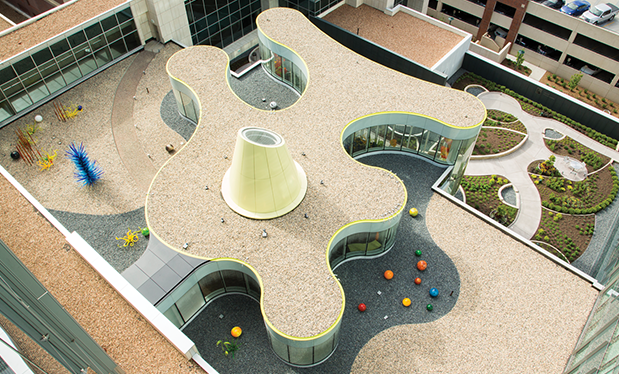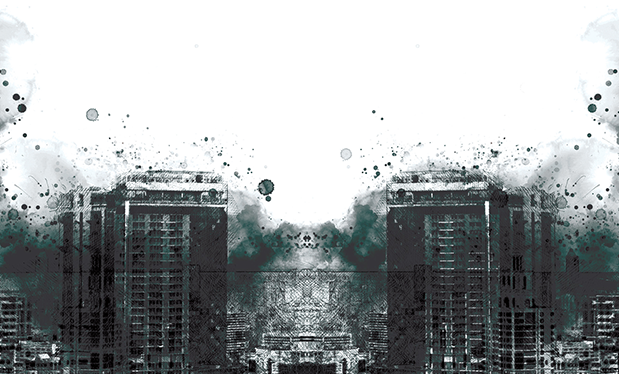Vegetative roof systems continue to be one of the most popular options for building owners who desire the addition of "sustainable" or "green" attributes for their buildings. Although vegetative roof systems can add many benefits, it is important they be designed and installed carefully to avoid sacrificing the weather-resistive properties all roof systems should provide.
In September, NRCA published The NRCA Vegetative Roof Systems Manual—Third Edition. The manual provides up-to-date NRCA best practices applicable to the design and installation of quality vegetative roof systems. The newest edition replaces The NRCA Vegetative Roof Systems Manual—Second Edition, published in 2009, and includes the following updates:
- Revised waterproofing membrane recommendations for use with vegetative roof systems
- Expansion of waterproofing membrane design and installation information
- Expansion of structural roof deck information
- Updated standards and codes references applicable to vegetative roof systems
- Revised guidelines for electronic leak detection (ELD) methods
- Roof system flashing height revisions
Revised waterproofing recommendations
As with the manual's second edition, NRCA recommends a protected-membrane configuration consisting of a built-in-place vegetative roof system with growth medium and plantings installed over an adhered waterproofing membrane; NRCA also provides information regarding extensive vegetative roof systems over conventional membrane roof systems.
In the recommended approach, the waterproofing membrane adhered directly to the deck or suitable substrate is shielded from the elements and mechanical damage by the vegetative roof system components, which may include moisture-resistant insulation and its overburden. The vegetative roof waterproofing membrane provides hydrostatic resistance for the expected amount of water drainage and retention, but it relies on the vegetative roof system components and overburden for protection from ultraviolet radiation and temperature extremes.
The other vegetative roof system construction method incorporates a conventional membrane roof system designed to be a fully functional roof in the event the vegetative roof components and overburden are removed. As a fully functional roof, the membrane roof system should provide positive drainage but is not required to withstand significant hydrostatic pressure. In a conventional membrane roof system, thermal insulation is installed below the roof membrane and generally is not selected for its moisture resistance.
The protected-waterproofing membrane vegetative roof configuration is appropriate for all types of vegetative roof systems as defined by the depth of the growth medium, provided the waterproofing membrane's hydrostatic resistance is appropriate for the amount of hydrostatic pressure expected for fully saturated vegetative roof system components, including the growth medium.
Only extensive (shallow) vegetative roof systems are appropriate for installation over conventional membrane roof systems.
The types of NRCA-recommended adhered roof membranes for use with vegetative roof systems in a protected-membrane configuration have been expanded and now include the following:
- Hot-fluid-applied polymer-modified asphalt membrane fabric-reinforced—nominal 215 mils minimum thickness
- Built-up roofing (BUR) membrane—four-ply minimum
- APP and SBS polymer-modified bitumen sheet membrane—two-layer minimum
- Ethylene propylene diene terpolymer (EPDM) single-ply membrane-reinforced—60 mils minimum thickness
- Polyvinyl chloride (PVC) single-ply membrane-reinforced—60 mils minimum thickness
- Thermoplastic polyolefin (TPO) reinforced—72 mils minimum thickness
- Ketone ethylene ester (KEE) single-ply membrane-reinforced—60 mils minimum thickness
- One- and two-component liquid-applied membranes fabric-reinforced—90 mils minimum finished thickness
The types of NRCA-recommended adhered roof membranes for use with extensive (shallow) vegetative roof systems in a conventional-membrane configuration also have been expanded and now include the following:
- APP and SBS polymer-modified bitumen sheet membrane—two plies minimum with all seams heat-fused regardless of the membrane attachment method
- EPDM membrane-reinforced—60 mils minimum thickness
- PVC membrane-reinforced—60 mils minimum thickness
- TPO membrane-reinforced—72 mils minimum thickness
- KEE membrane-reinforced—60 mils minimum thickness
- BUR membrane—four-ply minimum
NRCA considers stripping in the seams of EPDM, TPO, KEE and PVC roof membranes as good practice for ensuring reliable membrane performance.
Expanded design and installation information
For each recommended membrane type, design and installation information has been updated and expanded from the manual's second edition.
Expanded structural deck information
As with the manual's second edition, information about concrete, steel and wooden structural roof decks is provided but has been expanded, and design and drainage guidance has been added for the third edition.
Updated standards and codes references
The short appendix addressing standards and codes has been moved to the manual's main body and expanded to include the following:
- Descriptions of vegetative roof system-related standards by ASTM International and SPRI
- Descriptions of vegetative roof system-related documents by FM Approvals
- Vegetative roof system-related code references from the International Building Code, 2015 Edition
Revised ELD guidelines
Quality-assurance and membrane-integrity testing information has been updated to reflect the changes that have occurred in the roofing industry related to ELD. Guidance regarding low-voltage ELD methods has been updated, and information regarding high-voltage methods has been added.
Roof system flashing height revisions
NRCA now recommends a base flashing's height be at least 8 inches above the growth medium's surface. Relevant construction details have been updated to reflect the 8-inch dimension.
Get it
I encourage every roofing professional to update his or her library with NRCA's best practice guidelines for vegetative roof systems. NRCA members have free electronic access to The NRCA Vegetative Roof Systems Manual—Third Edition via NRCA's online bookstore, shop.nrca.net, and on the NRCA app. A hard copy of the manual also is available for purchase.
Jason Wilen, AIA, CDT, RRO, is an NRCA director of technical services.
The manual addresses:
- Vegetative roof systems as a roof area of plantings/landscaping installed above a waterproofed substrate at any building level that is over habitable space
- Vegetative roof assemblies as a substrate and a vegetative roof system
- Waterproofing as treatment of a surface or structure to prevent the passage of water under hydrostatic conditions
Scope and layout
The NRCA Vegetative Roof Systems Manual—Third Edition contains the following four chapters and four appendixes:
Chapter 1: Design Considerations
Chapter 1 provides an overview of general information concerning the design and installation of quality vegetative roof systems and represents the consensus of professional vegetative roof system contractors throughout the U.S.
Chapter 2: Standards and Codes
Chapter 2 provides an overview of the standards and model codes applicable to vegetative roof systems.
Chapter 3: Vegetative Roof System Guidelines
Chapter 3 provides in-depth technical information concerning the design and installation of quality extensive, semi-intensive and intensive vegetative roof systems. Built-in-place and modular (sometimes called "tray") system configurations are addressed.
Chapter 4: Vegetative Roof System Construction Details
Chapter 4 includes information applicable to the construction of all vegetative roof systems, as well as 55 construction details—eight are generic, and the remaining construction details are separated by vegetative roof waterproofing membrane types.
The following appendixes also are included:
- Water-test Procedures
- Electronic Leak Detection Methods for Locating Leaks in Waterproofing Membranes
- Membrane Integrity Test Verification Form
- Glossary
A vegetative roof system consists of a waterproofing system and its associated components—such as protection course, root barrier, drainage layer and thermal insulation—and an overburden of growth medium and plants (selection of specific growth medium, plants and vegetation is outside the scope of the manual).
Energy codes and standards
Vegetative roof systems are listed in common energy codes and standards as alternatives for providing highly reflective roof surfaces in Climate Zones 1-3 (southern U.S.). The current versions of the International Energy Conservation Code® and ASHRAE 90.1, "Energy Standard for Buildings Except Low-Rise Residential Buildings," offer such alternatives for commercial buildings.
Current versions of the Green Building Initiative's Green Globes building assessment and certification program and the U.S. Green Building Council's LEED system offer credits for projects that include vegetative roof systems that meet minimum guidelines for coverage or stormwater retention.
Although current mainstream "green" certification programs and energy codes contain voluntary provisions, some local jurisdictions recently have decided to mandate using vegetative roof systems for some buildings.
In January 2010, the city of Toronto began requiring vegetative roof systems on new commercial, institutional and multifamily residential developments (industrial developments also were included in 2012). In January 2017, San Francisco began to require all new construction projects to have at least 30 percent of roof areas include vegetative roof systems or photovoltaic panels.
In Denver, the Denver Green Roof Initiative obtained enough signatures to add a vegetative roof system-related ballot measure to the November 2017 ballot. According to The Denver Post, the ballot measure " … would require most new buildings of at least 25,000 square feet to have gardens, solar panels or other 'green roof' components cover at least 20 percent of their roofs' surface, depending on a building's size. Roof replacements on existing buildings also could trigger the requirement." If passed by voters, the Denver ordinance would affect new construction projects undertaken after Jan. 1, 2018.



